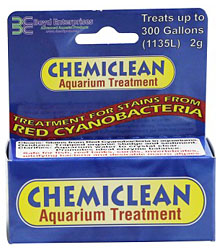Aquarium Algae Treatment & Control
Algae growth is easy to manage using various methods to keep it under control, such as algae eaters, scrapers, and algae treatments. However, algae need three things to survive: water, light, and nutrients, and if there is excess of these, excessive growth of algae is bound to occur. Overgrowth typically begins in the initial stages of tank setup when the ecological balance has not been established, but also when the ecology of the aquarium is out of whack, or when water is being changed infrequently.
Introducing algae eaters such as Amano shrimp and nitrite snails are always a good choice in established tanks. They enjoy eating on algae as well as other plant matter in your aquarium. Algae treatment is also a very beneficial option as it prevents excessive adhesive algae and phytoplankton in fresh and salt water including: bush, beard, thread, brown, slime and red algae, and water blossom. Algae treater can also be used for prevention of algae on newly added water plants. When used as directed, it is completely harmless to aquatic plants and animals. Algae killer is an effective algaecide against all types of aquarium algae. Low dosages are required to prevent algae growth, making it safe for fish and plants. It will not interfere with plant fertilizers. However, use caution with algae treatment in invertebrate tanks. Because algae can easily and quickly build up in your aquarium, proper aquarium algae control is a necessary part of tank maintenance. Creating a healthy environment and habitat for your plants and inhabitants is the primary focus to every hobbyist and having the right tools to do so will lead to nothing but success for your aquarium!
Types of Algae
Algae exist in so many different types and forms that it is sometimes difficult to determine which kind(s) you have in your aquarium without research. Below is a list of algae types that have the potential to grow in your aquarium.
- • Red Algae
- • Brown algae
- • Blue-green algae
- • Green spot algae
- • Green dust algae
- • Free-floating algae
- • Bacterial bloom
- • Green filamentous algae
- • Green thread algae
- • Reticulated algae
- • Staghorn algae
- • Black beard algae
Algae Habitats
Algae has the ability to live in freshwater lakes or saltwater oceans. Being a diverse group of organisms, algae can survive in a wide range of temperatures, oxygen or carbon dioxide concentrations, acidity and turbidity. Algae are also able to survive on land, on trees, and even on hot springs, mostly living independently in their different forms of growth. Algae are also able to live symbiotically with other organisms such as fungi, mollusks, and sponges. The fact that algae are able to grow and thrive in so many various habitats makes the issue of algae growth in aquariums a common problem, making aquarium algae control so important.
What is algae?
“Algae” is the name for many different organisms that are capable of producing oxygen through photosynthesis, though not are all closely related. As a microorganism, algae exists as prokaryotic and eukaryotic organisms, including cyanobacteria, also known as blue-green algae. Seaweed, pond scum, and algal blooms are familiar to most people, but there are numerous types of algae, particularly algae that will appear on the glass, substrate, or plants in a tank. Various types of algae are very beneficial to us and our existence, but investing in a beneficial and reliable algae treatment is the key to preventing algae buildup, and maintaining an aquarium that is appealing to the eye and balanced for the life inside it.



